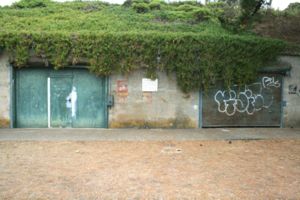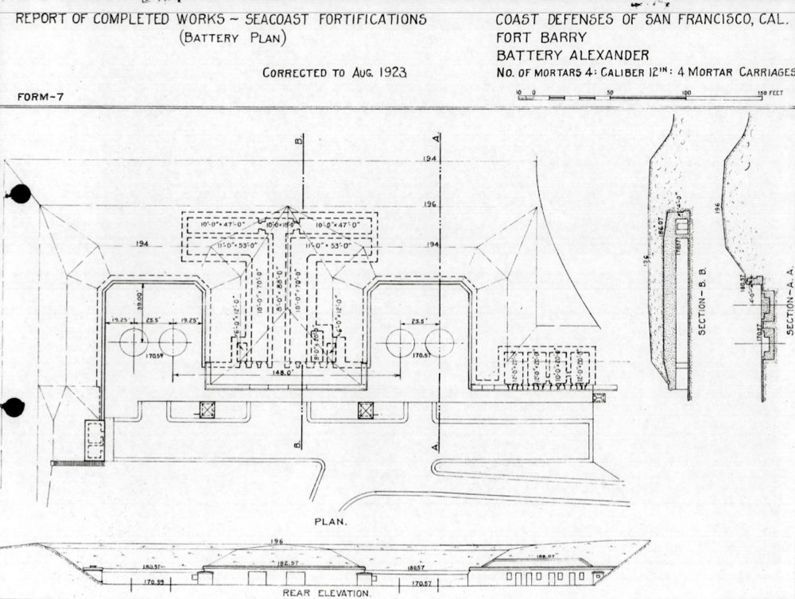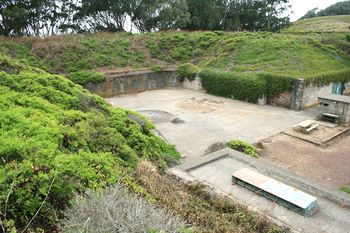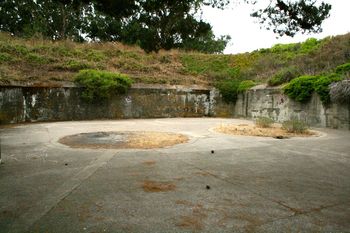Battery Alexander
|
Battery Alexander (1905-1943) - Battery Alexander was a reinforced concrete, Endicott Period 12 inch coastal mortar battery on Fort Barry, Marin County, California. The battery was named in G.O. 120, 22 Nov 1902 after Col. Barton S. Alexander, U.S. Corps of Engineers, bvt. Brig. Gen., who served with distinction in the Mexican-American War and the U.S. Civil War and who died at San Francisco, California, 15 Dec 1879. Battery construction started in 1901, was completed in 1903 and transferred to the Coast Artillery for use 8 Jun 1905 at a cost of $ 100,382.00. Deactivated in 1943.
Endicott Period (1890-1910)Part of the Harbor Defense of San Francisco. Originally built as an Endicott Period concrete coastal mortar battery with eight 12" M1890MI breech loaded mortars mounted on M1896MI mortar carriages. The mortars were distributed into two mortar pits (A and B) with four mortars apiece. Each pit is recessed and surrounded on three sides with 12' concrete walls.  The magazine for both pits is located between the pits with separate shell rooms (11' by 53') and powder rooms (10' by 47') for each pit. The magazine and the side wall are covered with 14' of earth on top of the structures. Four service rooms are located on the right rear of the battery, two data booths are located in the back and to the side of each pit and a separate building at the left rear of the battery housed the latrines. Long corridors in the magazine provide access to a magazine gallery which opens onto both pits. The shells were moved from the shell rooms via a ceiling mounted I beam trolley system which brought the shells out to the magazine gallery where they were loaded onto shot trucks and moved to the individual mortars. The silk powder bags were moved from the powder rooms into the magazine gallery by a floor mounted rail system and then to the mortars by cart. The battle allowance was 320 rounds and the war reserve was 320 rounds for this battery.

World War I (1917-1918)The U.S. entry into World War I resulted in a widespread removal of large caliber coastal defense gun tubes for service in Europe. Many of the gun and mortar tubes removed were sent to arsenals for modification and mounting on mobile carriages, both wheeled and railroad. Most of the removed gun tubes never made it to Europe and were either remounted or remained at the arsenals until needed elsewhere. On 3 May 1918 a directive was issued to dismount and prepare for shipment four 12 inch mortars at Battery Alexander for service elsewhere and by 18 Jul 1918, the mortars were listed as having been transferred. The gun cards indicate that the mortars were transferred 1 Jul 1918 to Morgan Engineering Company for modification, probably for use as railway mortars. None of the Mortars were actually shipped overseas and most of them were scrapped in the 1940s after being in storage for many years. These mortars were not replaced at Battery Alexander because it had been determined that it was more efficient and just as effective from a rate of fire perspective to have only two mortars per pit. The rear mortars were retained (1 and 3) in each pit and both forward mortars (2 and 4) were removed. This same configuration was adopted in many other mortar batteries and cut in half the number of men necessary to man each battery. World War II (1941-1945)Early in World War II (19 Nov 1942) the remaining mortars and carriages at Battery Alexander were ordered salvaged, probably as a result of the first large scale scrap metal drive of World War II in the fall of that year. Current StatusPart of the Golden Gate Recreation Area (GGNRA) administered by the National Park Service. No gun or mounts in place.
Sources:
Links: Visited: 19 Aug 2009 Picture Gallery
| ||||||||||||||||||||||||||||||||||||||||||||||||||||||||||||||||||||||||||||||||||||||||||||||||||||||||||







